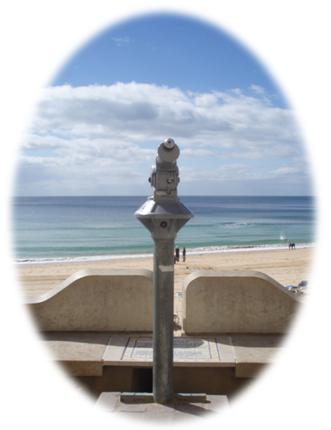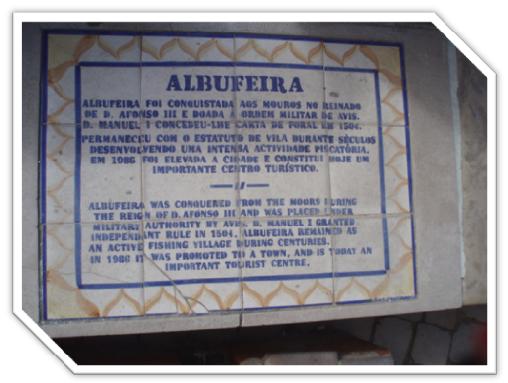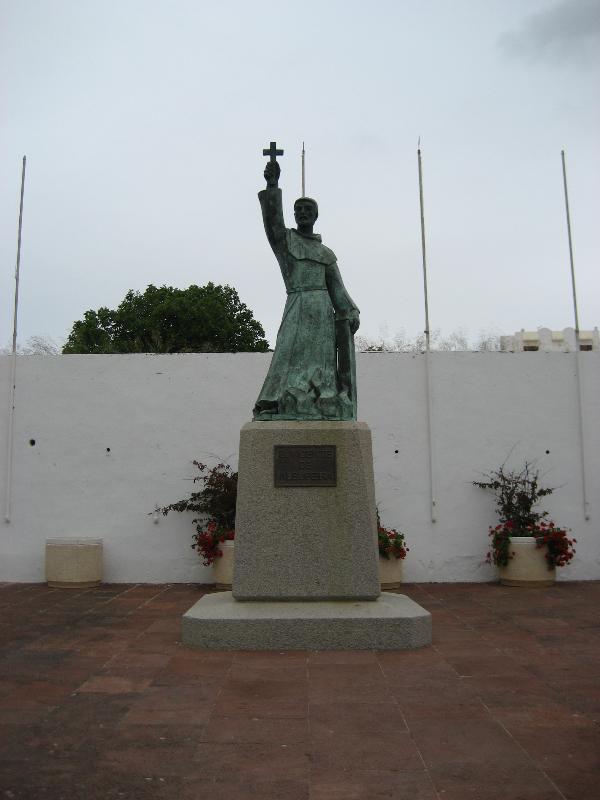

 Desconhecem-se as origens de Albufeira, mas tudo leva a
crer que a região já era povoada em tempos pré-históricos e que o
local onde hoje se ergue a cidade teria sido, alguns séculos antes
da nossa era, uma importante povoação com o seu porto marítimo.
Desconhecem-se as origens de Albufeira, mas tudo leva a
crer que a região já era povoada em tempos pré-históricos e que o
local onde hoje se ergue a cidade teria sido, alguns séculos antes
da nossa era, uma importante povoação com o seu porto marítimo.
A
primitiva povoação foi ocupada pelos Romanos que lhe deram o nome
de Baltum. Introduziram uma organização administrativa centralizada
e desenvolveram uma intensa actividade agrícola e comercial.
Construíram aquedutos, estradas e pontes das quais ainda hoje
existem vestígios.
O topónimo Albufeira provem da denominação árabe "Al-buhera" que
significa "castelo do mar", razão que poderá estar ligada à
proximidade do oceano e/ou da lagoa que se formava na zona baixa da
localidade. Os árabes construíram sólidas fortificações defensivas,
tornando-a quase inexpugnável, o que até certo ponto não era
infundado, porque Albufeira foi uma das praças que os árabes
conservaram por mais tempo em seu poder.
Quando D.Afonso III ocupou o trono, já parte do Algarve tinha caído
em poder dos cristãos. Templários e Hospitalários, ordens militares
que auxiliaram na Reconquista, salteavam frequentemente as terras
que ainda estavam sob domínio Árabe, mas detinham-se sempre diante
das fortes muralhas de Albufeira. Somente depois da tomada de Faro
é que a situação de Albufeira se tornou insustentável.
Cercada de inimigos por todos os lados, a praça caiu em poder de
D.Afonso III, que imediatamente a doou à Ordem de Aviz.
No reinado de D. Manuel I já a vila reconquistara a sua antiga
importância, pois este monarca concedeu-lhe foral em 20 de Agosto
de1504.
Albufeira foi das cidades algarvias a mais castigada por
cataclismos naturais. Mas foi o terramoto e que causou os maiores
estragos. O mar invadiu a vila com ondas que atingiram 10m de
altura, destruindo quase todos os edifícios, tendo apenas ficado de
pé 27 habitações e estas muito arruinadas.
A partir de meados do século XIX verificou-se um desenvolvimento da
economia graças à actividade piscatória.
Nas primeiras décadas do século XX registou-se um aumento acentuado
da exportação de peixe e de frutos secos. A vila tinha, então,
cinco fábricas que empregavam 700 a 800 pessoas, sobretudo mulheres
de pescadores.
No início da década de 60, assistiu-se ao nascimento do fenómeno
turístico, Albufeira foi procurada por turistas nacionais, mas foi
sobretudo com os ingleses que prosperou.
Na década de 80, verificou-se um enorme surto urbanístico, tendo a
cidade crescido para nascente, local para onde se transferiu a
maior parte dos serviços administrativos, incluindo a Câmara
Municipal.
PT: Não se esqueça de levar consigo esta fórmula!
ENG: Do not forget to take this equation with
you.
PT:
Sugestões para fazer esta multi-cache:
- Vá até ao ponto inicial e encontre um pequeno contentor que
contém a pista para o ponto seguinte. Cuidado com os
mugles!!!
- Leia com atenção as sugestões e siga para a coordenada indicada
(2.º ponto).
- No 2.º ponto, procure a estátua e retire as informações
necessárias.
- Depois de retirar a informação da "estátua" coloque os dígitos
na fórmula dada na página da cache; a conta irá dar o esconderijo
final.
ENG: To find this
multi-cache:
- Go to the initial point and find a small container. Inside
you'll find the clues to next stage. Beware of
mugles!!
- Read the suggestions carefully and go to the 2nd
point.
- At 2nd point, seek the statue and note the information you
need.
- Now put the numbers in the equation shown on the cache page.
The result will take to final hiding place.
A cache encontra-se em:
Nº The cacche is
at:
N
37º 05.(A)_
_ _-
1642
W 008º
15.
(B)
_ _ _- 1649
Exemplo: N 37º 05.458
W 008 15.798
Example:
...............................................
PT:
A
=
Data de Nascimento
- 1642
(-)
"subtrair"
B
=
Data da Morte -
1649
(-)
"subtrair"
ING:
A
= Date of Birth
- 1642
(-)
"
subtract
"
B
= Date of Death
- 1649
(-)
"subtract"

 The origins of Albufeira are not well known, but
everything leads to believe that the region already was populated
in prehistoric times and that the place where today the city is
risen would have been, some centuries before our age, an important
population with its maritime port.
The origins of Albufeira are not well known, but
everything leads to believe that the region already was populated
in prehistoric times and that the place where today the city is
risen would have been, some centuries before our age, an important
population with its maritime port.
The primitive population was busy for the Romans who had given the
name to it of Baltum. They introduced a centered
administrative organization and developed an intense
agricultural and commercial activity.
They build aqueducts, roads and bridges of which there are
still vestiges today.
The name Albufeira comes from the Arab denomination "
Al-buhera", and it means " castle of sea", reason that could be on
to the proximity of the ocean and/or of the lagoon that if it
formed in the low zone of the locality.
The Arabs had constructed solid defensive blockhouses,
becoming it almost indestructible, and Albufeira was one of
the cities the Arabs had conserved for more time in its
power.
When D.Afonso III occupied the throne, already part of the Algarve
had fallen in possession of the Christians. Templários and
Hospitalários, military orders that had assisted in Reconquista,
frequently attacked the lands that were stillunder Arab
domain, but were always lingered ahead of the strong walls of
Albufeira.
Only after the taking of Faro the situation of Albufeira
became unsustainable. Surrounded of enemies for all sides, the city
fell in the hands of D.Afonso III, who donated it immediately
to the Order of Aviz.
During the reign of D. Manuel I the village reconquers
its old importance, and therefore this monarch granted to it
charter in 20 of August de1504.
Albufeira was of the algarve cities most punished by natural
cataclysms. It was the 1755 earthquake that caused the greater
damages. The sea invaded the village with waves reaching 10m
high, destroying almost all the buildings, having
remained 27 habitations and these very ruined. From middle of
19th century a development of the economy thanks to the
fishing activity was verified. In the first decades of 20th
century an accented increase of the exportation of fish and
dry fruits was registered.
The village had, then, five plants that employed 700 to 800
people, most of them fishermans' wifes. At the beginning of
the 60's, with the birth of the touristic phenomenon, Albufeira was
looked by national tourists, but it was with the English ones
that it prospered.
In the 80's, an enormous building and construction urge made
the city grow rapidly specially on its eastern area, and most of
the administrative services, including the City council were
transfered there.
The cache:
Please leave the cache well
camouflaged

Cache colocado por Ruben Martins
adoptada por VespaFriendsAlgarve